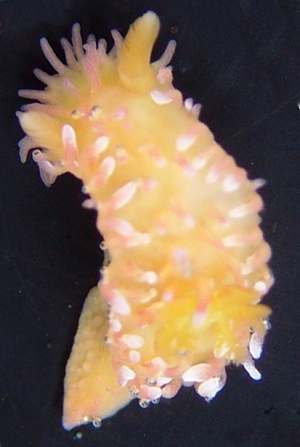
Colga pacifica
(Bergh, 1894)
Order: NUDIBRANCHIA
Suborder: DORIDINA
Superfamily: ANADORIDOIDEA
Family: Polyceridae
Subfamily: Triophinae
DISTRIBUTION
North Pacific - from Alaska to Shikotan Island (sthn Kurile Islands).
PHOTO
Aleutian Islands. Photos: Roger Clark
The genus Colga is known basically from preserved specimens. Apart from Lemche's illustration (Just & Edmunds, 1985) and Roger Clark's photos, we know nothing about living animals. The genus has been recently reviewed (Martynov & Baranets, 2002) and the authors consider there are 3 species, C. villosa [NW Atlantic - Barents Sea} C. pacifica [Nth Pacific: Alaska - Kurile Ids], and C. minichevi [Nth Pacific: Kurile Ids - nth Japan Sea]. From their published illustrations there seems to be no unambiguous way to distinguish the species externally on body shape and arrangement of papillae, other than that C. minichevi has a smooth edge to the rhinophore pocket while the other two species have a papillate edge. C. pacifica and C. villosa also have very similar radular morphology, with a large central tooth, while C. minichevi differs in having a very small, or sometime absent, central tooth. The three species are reported to differ in the arrnagemnt of their penial armature.
In general shape, species of Colga are similar in shape to Palio but differ in having simple, but elongate papillae arranged all around the edge of the mantle. There are also similar tapering papillae on the dorsum. In C. pacifica and C. villosa there is a distinct row of papillae down the midline, and there can be up to 3 or 4 parallel rows of papillae on either side of the midline. In C. minichevi it seems that the dorsal papillae are more irregularly scattered. Preserved specimens of C. pacifica reach up to 40mm in length. The genus names Issa Bergh, 1880 and Issena Iredale & O'Donoghue, 1923 are considered synonyms of Colga.
References:
• Martynov, A. V. & O. N. Baranets. 2002. A revision of the genus Colga Bergh (Opisthobranchia, Polyceridae), with description of a new species from the North Pacific. Ruthenica, 12(1): 23-43.
• Just H. & M. Edmunds. 1985. North Atlantic nudibranchs (Mollusca) seen by Henning Lemche. Ophelia, Supp. 2: 1-150.
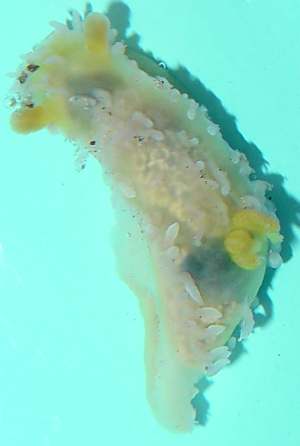
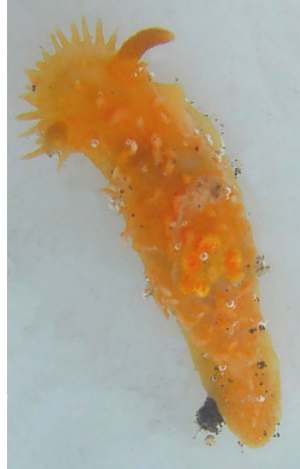
Rudman, W.B., 2003 (September 17) Colga pacifica (Bergh, 1894) . [In] Sea Slug Forum. Australian Museum, Sydney. Available from http://www.seaslugforum.net/find/colgpaci
Related messages
Re: Colga pacifica in situ
March 25, 2009
From: Jeff Goddard
Concerning message #22342:
Hi Bill,
Alex Martynov probably knows more, but the only information on the food of Colga pacifica that I am aware comes from a 1997 abstract by Grischenko and Martynov, cited in Martynov and Baranets (2002) and available via the link below, that C. pacifica and its congeners prey on arborescent and foliose bryozoans. No bryozoans are obvious in the in situ image of C. pacifica from Washington, but the resolution is not all that high.
The similarity of the radular teeth of species of Colga with known bryozoan specialists like species of Triopha and Polycera certainly also points to a diet of bryozoans.
-
Grischenko, A. V. and Martynov, A. V. (1997) Bryozoa as food items for the genera Colga and Triopha (Nudibranchia, Doridacea). Russian and International Conference on Bryozoa [Abstract available from: http://www.bryozoa.net/russabst.html ]
Best,
Jeff
goddard@lifesci.ucsb.edu
Goddard, J.H.R., 2009 (Mar 25) Re: Colga pacifica in situ. [Message in] Sea Slug Forum. Australian Museum, Sydney. Available from http://www.seaslugforum.net/find/22359Dear Jeff,
Thanks for the reference. I missed it in Martynov and Baranets reference list
Best wishes,
Bill Rudman
Colga pacifica in situ
March 19, 2009
From: Jeff Goddard
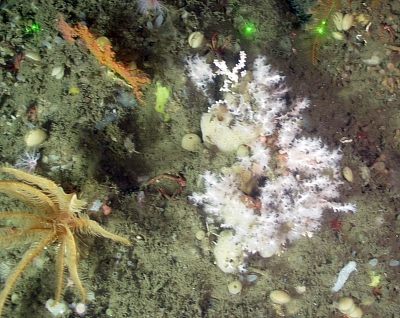
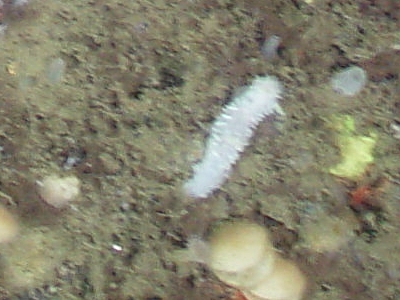
Concerning message #10978:
Hi Bill,
I've been identifying nudibranchs for the Olympic Coast National Marine Sanctuary in Washington State and thought this image of Colga pacifica in situ would be of interest. The distance between the green laser points is 10 cm [see top of upper photo], and some of the other organisms visible in the larger image are crinoids, gorgonians, brachiopods, holothuroid feeding tentacles, galatheid crabs, and various sponges.
Locality: 48.2581 degrees N, 125.01138 W, 170 m, Washington, USA, Northeast Pacific Ocean, 29 May 2006, Deep-water, rocky. Length: 5 cm. Photographer: Olympic Coast National Marine Sanctuary
To my knowledge this is the first record of C. pacifica off Washington. Henning Lemche identified it from a sample obtained in the mid 1960's from 247 m off the northern Oregon coast (Pereya and Alton, 1972; reviewed by Goddard, 1990).
-
Goddard, J. H. R. (1990) Additional opisthobranch mollusks from Oregon, with a review of deep-water records and observations on the fauna of the south coast. The Veliger, 33(3): 230-237.
-
Pereya, W. T. & Alton, M. S. (1972) Distribution and relative abundance of invertebrates off the northern Oregon coast. Pp. 444-474 In: A. T. Pruter & D. L. Alverson (eds.), The Columbia River estuary and adjacent ocean waters. University of Washington Press: Seattle, Washington.
Best wishes,
Jeff
goddard@lifesci.ucsb.edu
Goddard, J.H.R., 2009 (Mar 19) Colga pacifica in situ. [Message in] Sea Slug Forum. Australian Museum, Sydney. Available from http://www.seaslugforum.net/find/22342Thanks Jeff,
Do you know of we have any solid information on their food. I agree with the general thought that they are probably bryozoan feeders, but it would be nice to be sure.
Best wishes,
Bill Rudman
Colga pacifica from the Aleutian Ids
September 25, 2003
From: Dave Behrens

Bill:
Re mystery 'Triopha': I wouldn't swear to this but its a lot like Colga pacifica (Bergh, 1894). Martynov and Baranets just reviewed the genus. There is also a drawing in Just & Edmunds. Here are some photos by Roger Clark which were taken in the Aleutian Islands.
I shared these photos with Drs. Alexander Martynov and Olga Baranets at the Laboratory of Marine Research in Saint Petersburg, Russia who have been studying this genus and they confirmed the identification as C. pacifica. Both expressed excitement in seeing Roger's photos of this species because they had only seen preserved specimens from trawl samples and had never seen living material. Alexander replied to me - "All three specimens from the photos have the typical pattern of pre-branchial notal processes (very similar to Atlantic C. villosa , but the later species often has more rows on the back). A main row of elongate processes runs down the middle of notum and usually a pair of rows of similar processes accompanied it from the both sides. In some specimens these lateral rows are almost same length as the middle row."
The importance of Roger's photos is we can see the previously unpublished variation in color found in this species. Specimens vary from pure white with yellow gills and rhinophores shown above, and as described originally by Bergh, to specimens that are completely orange
I have written a fuller account for Mike Miller's Opisthobranch of the Week - week 354 .
References:
• Martynov, A. V. & O. N. Baranets. 2002. A revision of the genus Colga Bergh (Opisthobranchia, Polyceridae), with description of a new species from the North Pacific. Ruthenica, 12(1): 23-43.
• Just H. & M. Edmunds. 1985. North Atlantic nudibranchs (Mollusca) seen by Henning Lemche. Ophelia, Supp. 2: 1-150.
Dave Behrens
dave@seachallengers.com


Dear Dave,
Thanks for sharing these photos. As you report on Mike Miller's site, we know almost nothing about living animals of this genus. I don't think Paul Simm's mystery is a species of Colga as there appear to be a quite orderly arrangement of compound tubercles down the edge of the mantle on each side, quite unlike the simple papillae found in Colga. While your message doesn't resolve Paul's little mystery, it is certainly nice to see photos of living Colga. I'm afraid drawings of preserved specimens, no matter how well executed, leave something to be desired.
Thanks again,
Bill Rudman
